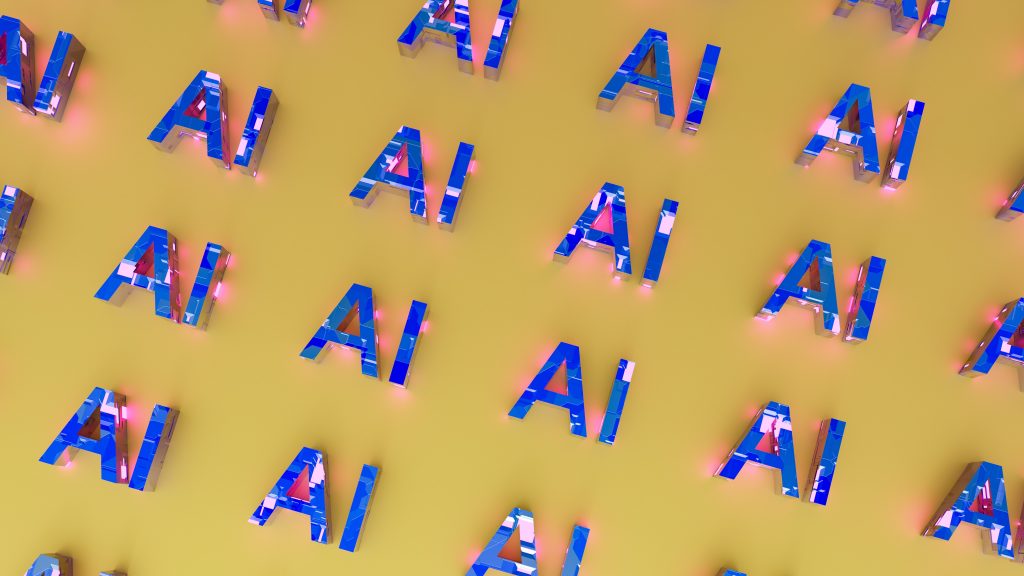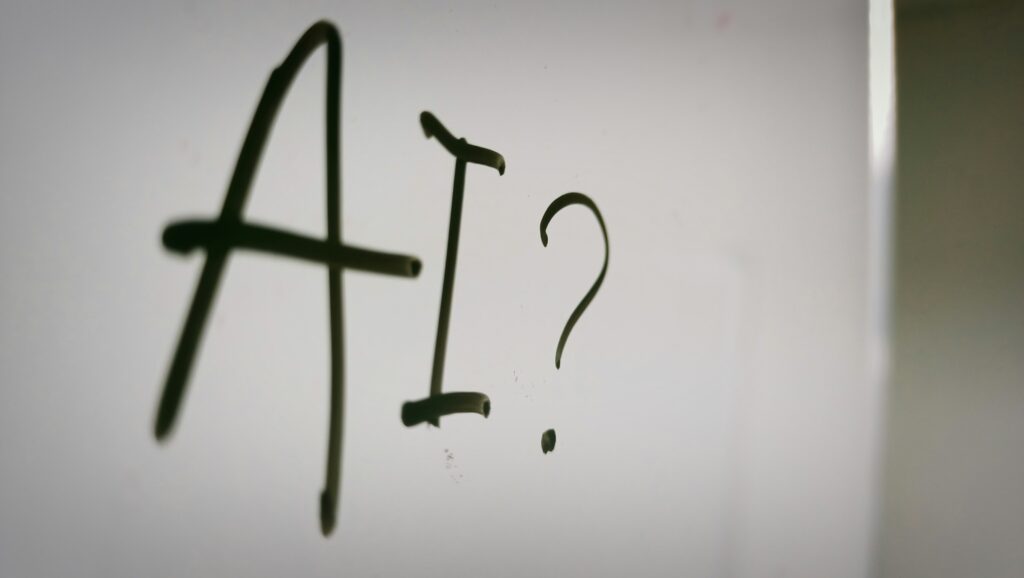This article analyzes the top AI detector tools on the market and explores their features (pros and cons) to help you decide on the best AI essay checker for your needs.
Why are these instruments so popular?
After ChatGPT’s boom in 2022, its alternatives started growing like mushrooms after a rain. More and more people use AI to generate content for their blogs, websites, assignments, etc. The problem? Many people abuse and misuse these AI writers, thus damaging the concept of authorship, sacrificing content quality, and ruining their brand reputation, academic performance, or business.
AI detectors help minimize those risks.
Keep reading to see how they do it, and choose the most trustworthy AI content detector to ensure the originality of your written works.
Table of contents
Why Do We Need an AI Checker?
One huge problem with ChatGPT and its fellows is that they aren’t as intelligent as many believe. These tools can’t write original, creative, and insightful texts. They don’t understand word meanings and semantics. All they do is scan the content databases, extract statistical patterns, predict likely word sequences, and combine them into sentences.
What do we have as a result?
- Generic information with no human perspective, expertise, and emotion
- Poor-quality writing that sounds like it came from a 5th-grader (primitive and monotonous text structures, cliches, truisms, poor word choice, overly lengthy phrases, etc.)
- Possible plagiarism or presentation of false information from the internet as if it were true
Anything else? Tons of similar or identical balderdash pulled from many websites and assembled from Search Engine Result Pages (SERPs).
Speaking of Google, by the way:
The use of AI content concerns academic integrity and some say presents a threat to the overall development of students’ writing and communication skills in education. Meanwhile search engines see its improper use as spam and ban websites or lower their rankings in SERPs for its use.
With that in mind, savvy website owners don’t trust their content writing to AI. They state that this is a no-no in their content creators’ guidelines and ask their contributors to check drafts via AI detector tools to ensure that their texts don’t look AI-generated.
The same is true in education. In addition to plagiarism checkers, teachers now use AI detector tools to scan students’ essays to see if they contain common AI text patterns.
How Can an AI Scanner for Essays Help You?
Are you a college student?
A reliable AI detector for essays will help you avoid plagiarism issues and penalties from teachers. It will highlight AI sentences for you to rewrite and, thus, make your writing assignments more original and insightful.
Are you a content writer or website manager?
Use an AI scanner for essays to polish your content and fill it with engaging narratives, expert insights, credible data, added value, and human perspective — everything that AI writers can’t bring but that readers crave.
Here’s how copywriter Eddie Shleyner describes his experience with ChatGPT-like tools:
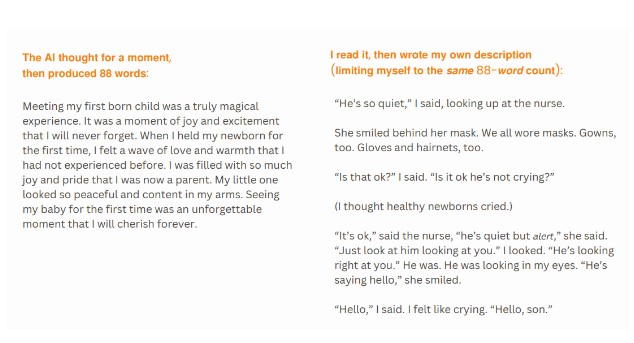
To test the most popular AI writing detector tools, we asked ChatGPT to generate a short text that popular AI detectors would recognize as created by a human. Here’s its fragment:

We took that text and gave it to the most popular AI detectors. Here’s what we’ve got:
22 Best AI Text Detectors in 2025
#1 Writer
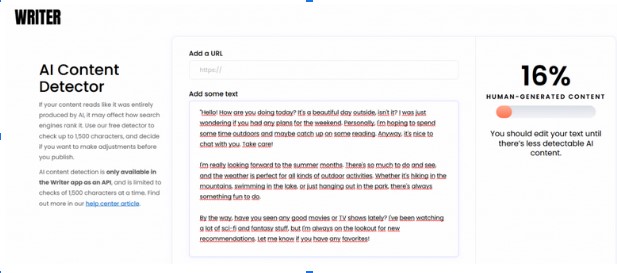
This AI checker is an easy-to-use tool with a business-oriented positioning model. It combines convenient functions like an AI content generator, AI content detector, free grammar checker, and style guide to help clients create consistent content. To check your text, paste it to the corresponding field, push the “Analyze text” button, or enter the page link you want to analyze.
Pros
- Free to use
- Accurate in detecting GPT-3 and ChatGPT-generated content
- Many other writing tools are available
- An add-on for Chrome
Cons
- A limited number of words to analyze (350 words or 1,500 characters)
- The tool doesn’t highlight the specific parts of your text that it recognizes as AI-generated. You’ll only see the overall percentage
#2 Grover EssayShark AI Detector

This tool deserves a high place on our list thanks to its stellar usability and up-to-date algorithms, which ensure high accuracy of its results. It helps detect AI-generated content and prevent lots of issues with your texts.
Pros
- Free to use
- Helps you improve the level of your texts
- Fast, high-quality content check
Cons
- Your “check my paper for AI” requests are available for 250-symbol long texts only
Start with opening the AI essay detector, then copy your text to check with the tool. Paste it and press the button to set the process in motion. You will get accurate results in just a few seconds. The AI detector highlights sentences that look artificial and which should be rewritten.
Tip: If your AI checker for essays has a word or character limit, why not revise your text by parts?
Another tip: Even if you write an essay or other paper from scratch, have a personal writing style, and are sure that your text is original, we recommend you scan it via Grover EssayShark AI Detector. Many teachers use it to be sure their students didn’t generate their works with AI; by checking your draft before submitting, you’ll ensure that none of your sentences sound artificial.
#3 Grover

Grover is a new system developed by computer scientists from the University of Washington and Allen Institute for AI (AI2). It is proficient in writing convincing fake news on many topics and styles – and, as a result, it is also good at detecting it. With its advanced algorithms, this AI text detector can identify fabricated stories that may have previously gone unnoticed.
Pros
- Perfect for detecting fake news
- Its simple algorithms do not require many actions from a user to input
Cons
- The accuracy of results could be better
- The tool doesn’t highlight AI-looking text excerpts, only providing a generic result – that is, determining whether the overall text is AI-written or not
#4 Smodin
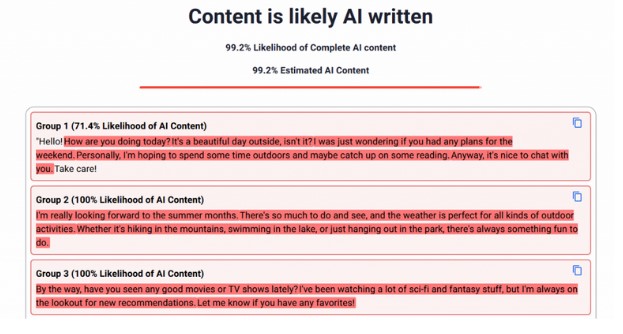
It is an all-in-one tool that helps you generate content, rewrite it, check it for plagiarism, and analyze it to detect AI writing. Once you register at their website, you can use the tool for free, with three credits per day. The free option allows you to analyze texts no longer than 5,000 characters. To increase this number to 50,000 characters, you must choose the “Essentials” plan, which will cost you $10/month.
Pros
- You can see all the sentences classified as AI-generated
- You can check tone and style consistency
- Numerous additional options to use
Cons
- 5,000 character limitation
- Quite expensive fee-based monthly plans
#5 Copyleaks
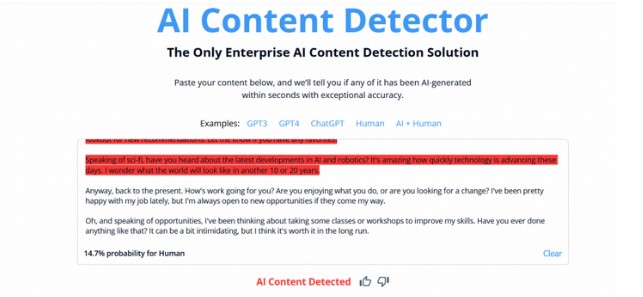
This AI checker promises you 99% accuracy. However, it makes some mistakes in falsely recognizing human-created content as AI-generated. Overall, it is a fast and easy-to-use tool that presents results in the blink of an eye.
Pros
- No registration required
- Five credits per day to check your texts for free
- Highlights AI-looking text and overall percentage of AI-generated content
- An add-on for Chrome is available
Cons
- Needs accuracy improvements
- Often has bugs
 Expert says:“If you choose Copyleaks, I recommend you try its paid version, which is more accurate and comfortable. The free one can drive a writer crazy: It often sees a human-written text as AI, even after you revise and improve its language, structure, and overall content.Anyway, I’d scan a text via several AI checkers to compare results and decide on corrections.”Melissa Mae, writing teacher at EssayShark Expert says:“If you choose Copyleaks, I recommend you try its paid version, which is more accurate and comfortable. The free one can drive a writer crazy: It often sees a human-written text as AI, even after you revise and improve its language, structure, and overall content.Anyway, I’d scan a text via several AI checkers to compare results and decide on corrections.”Melissa Mae, writing teacher at EssayShark |
#6 TraceGPT
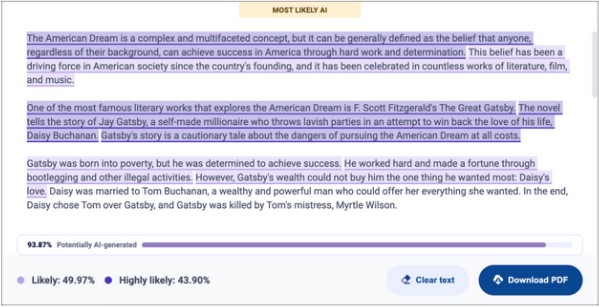
TraceGPT is an accurate AI content detector that analyzes various parameters to detect AI content from ChatGPT, Google Bard, and different AI bots. It provides user-friendly results and minimizes false positives, i.e., when a human text is recognized as AI-generated.
Pros
- 97% accuracy
- Saves texts from being leaked or reused
- You can download a PDF report with the result of your text check
Cons
- It allows you only 250 words to check
#7 Sapling
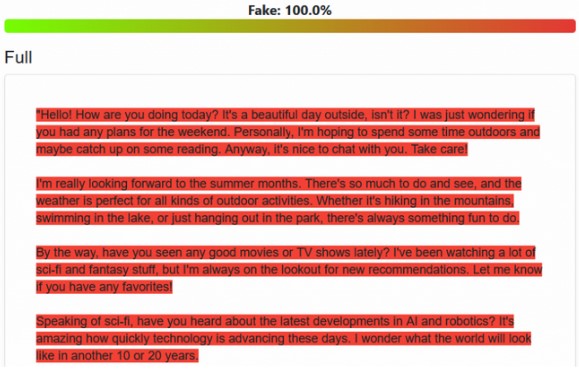
It is another AI detector with high speed and a user-friendly interface. The tool’s level of accuracy is high, as it recognizes our fake text as AI-generated. Its free version is limited to 2,000 characters, but you can check up to 8,000 characters if you become a Pro subscriber.
Pros
- Shows a detailed analysis, marking all the artificially created sentences
- Offers add-ons for different browsers, Outlook, Word, and Google Docs
Cons
- Can unexpectedly collapse while processing your text
#8 Kazan SEO
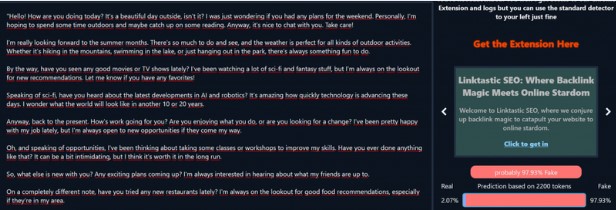
Kazan SEO is a multifunctional tool offering many services besides AI text detection including: text extractor, content optimizer, bulk detector, keyword clustering, and more. This AI content detector is perfect for digital marketers and SEO specialists who work with massive data sets and require accurate results quickly.
Pros
- Works fast
- Easy and free to use
- Deals with analyzing lengthy texts and numerous content assets simultaneously
- Great for analyzing links
Cons
- It doesn’t highlight which particular sentences or paragraphs are AI-generated
#9 Crossplag
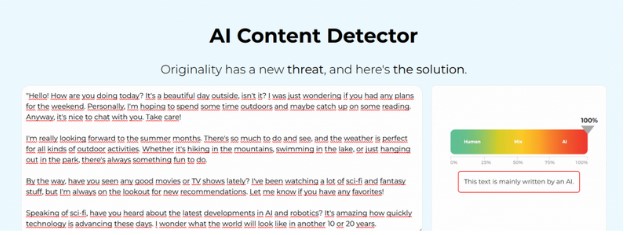
This AI text checker uses machine learning algorithms and natural language processing techniques to detect the origin of content. Even though it is free to use, you should be aware that it’s the early version of the tool. The developers state that they’ve crafted it for illustration purposes. Solution? Use Crossplag as an alternative tool to confirm or question the results of your primary AI checker.
Pros
- Works fast
- Gets regular updates to improve the accuracy
Cons
- Fails to highlight AI-generated excerpts; showcases an overall percentage of AI content only
- Some bugs are still present
#10 GPTZero
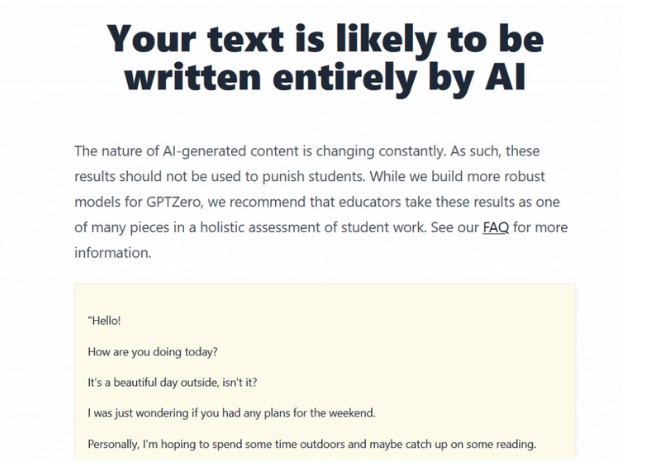
Initially a Chat GPT detector, this tool is now among the most popular AI-generated text checkers on the market. With over a million users, GPTZero is a great instrument for students and teachers. It’s easy to upload multiple files or paste a short text in the corresponding field to get analysis results in seconds.
Pros
- Highlights sentences containing AI text patterns
- Provides additional statistics on perplexity and burstiness
- Free to use
Cons
- Only 5,000 characters are available to check in the free version
#11 Hugging Face
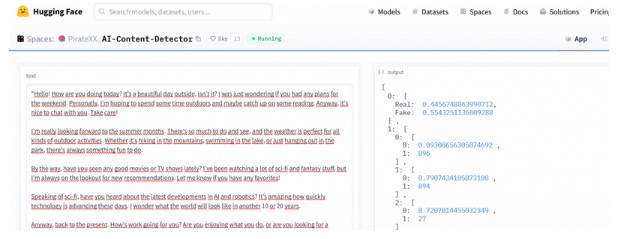
Some may consider this AI checker outdated, as it can only detect GPT-2-generated content. Also, it could be more accurate. Make sure to double-check your texts elsewhere to avoid misrepresentation of your content. As you can see, the tool made a false assumption that our ChatGPT-generated text was 44% real, i.e., written by a human.
Pros
- Free to use
- User-friendly interface
Cons
- Needs accuracy improvement
- Shows only general score without highlighting the sentences that need rewriting
- Takes up to 10 seconds to analyze a short text
 Expert says:“Hugging Face can detect AI-written content by GPT-3 and chatGPT! However, since it’s trained on GPT-2 data, it’s inaccurate with newer topics and writing styles. Another drawback I would mention is that their website is often down.”Frederick Poche, content marketer at EssayShark Expert says:“Hugging Face can detect AI-written content by GPT-3 and chatGPT! However, since it’s trained on GPT-2 data, it’s inaccurate with newer topics and writing styles. Another drawback I would mention is that their website is often down.”Frederick Poche, content marketer at EssayShark |
#12 GLTR
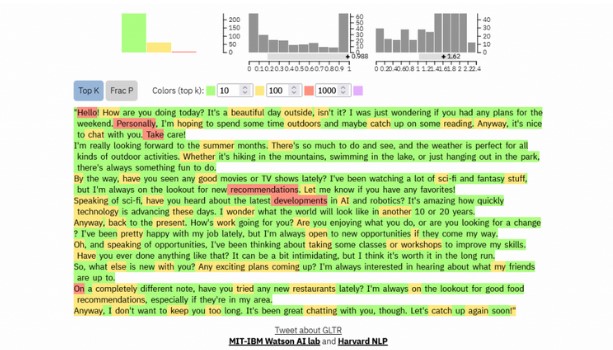
It is one of the early versions of AI writing checker tools and, therefore, can successfully analyze GPT-2 texts. It has an unusual algorithm for processing input texts: GLTR analyzes the predictiveness of using every word after the word to the left. The green color here means that the used word is in the top 10 predicted ones. Carefully read the explanation on the website to understand the result you get. As our test text analysis shows, the sample text is highly likely to be AI-generated.
Pros
- Perfect for scientific publications analysis
- Accurate for analyzing early versions of ChatGPT
- Visually presented results
- Multiple metrics
Cons
- It might be challenging to understand and interpret the results
- A bit outdated
#13 GPTradar
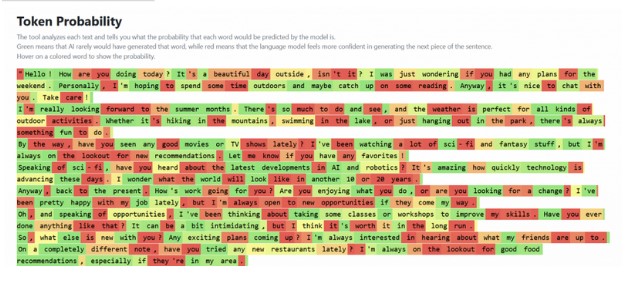
Creators used GPT-3-generated texts to train GPTradar. So, this Chat GPT checker should be a reliable tool for bringing up any content that meets Google’s standards. However, its accuracy is far from perfect as it recognizes our test text as human-written. The tool has a reasonable pricing of $0.02 per credit, where one credit equals approximately 125 words.
Pros
- Visually delivered and detailed results
- Ensures compliance with Google guidelines
Cons
- Needs accuracy improvement
- It can be challenging for new users to understand the results
#14 AI Detector Pro
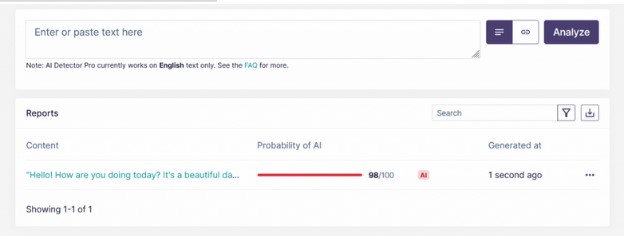
This AI content detector can recognize texts and passages created by GPT-3 and GPT-2. It’s fast and free to use. This tool detects AI content in English, German, and Spanish, highlighting overused words and phrases. A nice bonus is that AI Detector Pro can also provide rephrasing suggestions for your English texts.
Pros
- Offers a detailed analysis in multiple languages
- Presents visually-based results
- Provides a tone report to ensure that your text sounds human
Cons
- Up to 200 words per one analysis limitation
#15 Winston AI
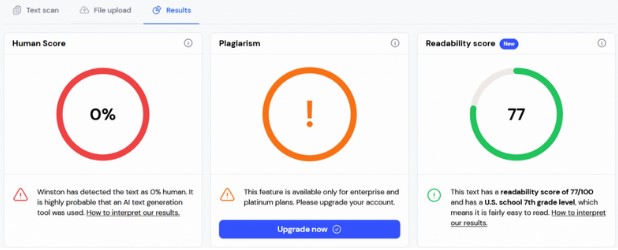
It is one of the more recently developed AI text detector tools, and it’s more accurate than many of its “colleagues.” The developers trained Winston AI using GPT-3, ChatGPT, Jasper, Copy AI, and other modern AI models. It is the only tool with optical character recognition so far. You can access its multiple features by choosing among the upgraded plans (e.g., Growth for $14 per month).
Pros
- Shows a detailed sentence-per-sentence analysis
- Can extract and analyze texts from scanned docs and handwritten notes
- Offers printable PDF reports
Cons
- Plagiarism checking isn’t free
- 3,500 words scan limitation
- Still not 100% accuracy
| Even the best AI detectors don’t give 100% accuracy. Check your texts several times via several tools and adjust your writing accordingly. |
#16 Content at Scale
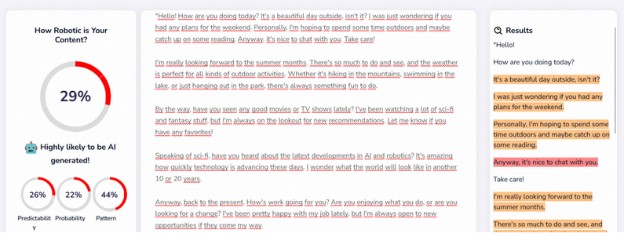
It is a relatively new, free-to-use AI content detector that works with GPT-3 and ChatGPT-generated texts. It is also an excellent tool for content creation. This platform combines three AI engines, Natural Language Processing (NLP), and semantic analysis algorithms to create content types that other detectors cannot mark as AI-generated.
Pros
- Gives a detailed analysis of texts with a sentence-by-sentence breakdown
- Provides additional statistics
- A limit of 25,000 characters, which is more than other free detectors allow
Cons
- It has lower accuracy than some of the paid tools
#17 OpenAI Text Classifier
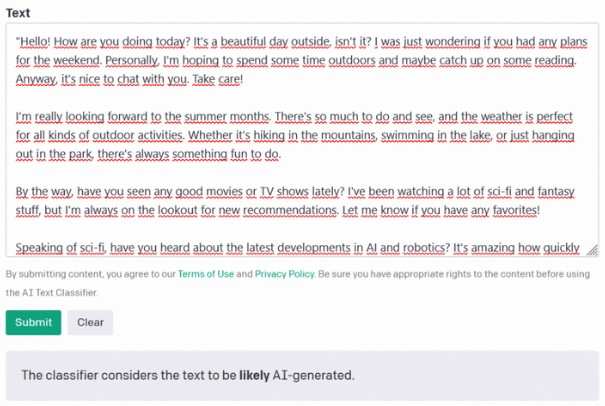
This AI text detector is by ChatGPT creators, and users expected effective and impressive results when it appeared. Yet, it’s a standard tool waiting for you to create an account to get generic reports for your text analysis. Open AI Text Classifier won’t highlight problematic areas in your document, sharing a universal verdict like “The classifier considers the text to be likely AI-generated” instead.
Pros
- Free to use
- No word number limitations
Cons
- Accuracy issues
- Requires a minimum of 150 words to start the analysis
- Presents only an overall score without giving any explanations
- No plagiarism check is available
#18 ZeroGPT
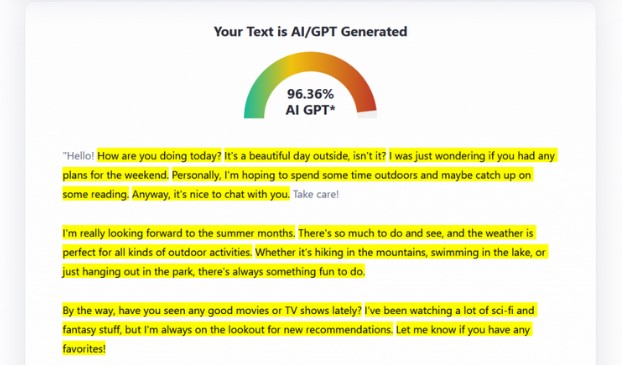
This AI text detector is a first-rate option for college students as it’s free to use and has no limit on the number of words you can test. A fly in the ointment here is that 98% accuracy still doesn’t guarantee 100% plagiarism-free content. The tool sometimes classifies human-created content as artificially generated, so it would help to trust a professional essay writer with your paper to ensure that your assignment meets academic writing requirements.
Pros
- Highlights the sentences that are most likely AI-generated
- No word number limitations
Cons
- Does not give you any additional information about the analyzed text
- No plagiarism detection
#19 Corrector AI
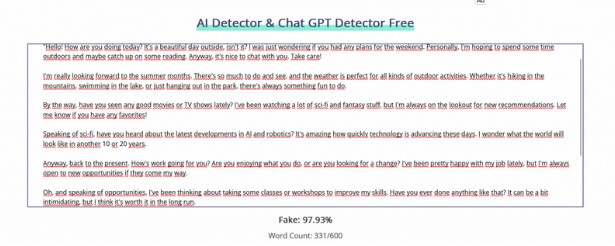
This free AI content detector works fast but presents only a general analysis of texts. Like most other corresponding tools, Corrector AI employs natural language processing techniques and machine learning to recognize issues and allow you to make necessary improvements. It supports many languages, including Arabic, Mandarin, Japanese, and Hindi. The only drawback is that you will not get any details or highlighted sentences and will need to request a demo version for a more detailed overview.
Pros
- Easy to use
- High accuracy
Cons
- 600-word count limit
- No detailed analysis, just a percentage score
- No plagiarism check
#20 Writefull ChatGPT Checker

This ChatGPT checker allows students to scan their academic papers for AI text patterns. Its creators trained the tool on millions of scientific articles, so it understands the principles of academic writing and offers sentence improvements in addition to a language check. It has additional widgets like Paraphraser and Title Generator, but students can’t check their drafts for plagiarism here. A reliable essay writing service with expert editing tips would be helpful anyway.
Pros
- Free to use
- Many additional services like Abstract Generator, Academizer, and others
- No word count limits
Cons
- No detailed analysis
- No plagiarism check
#21 Hive Moderation AI-Generated Content Detection
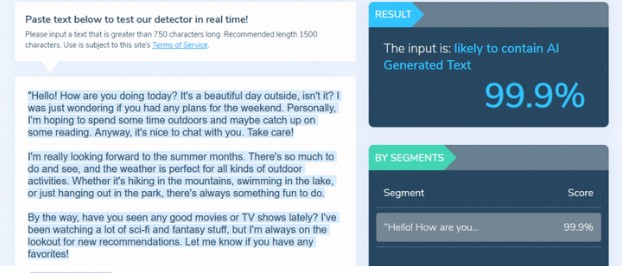
This AI detector is impressively accurate and works fast. You can also see the score percentage of every input text segment. It is an effective platform for quick checks, although you will need to create an account to use it regularly.
Pros
- High accuracy
- Free of charge
- Shows a score percentage by text segments
Cons
- Maximum of 8,192 characters to check
- Sign-in request after several uses
- No plagiarism check
- No detailed analysis
#22 Paraphrasing Tool AI Content Detector
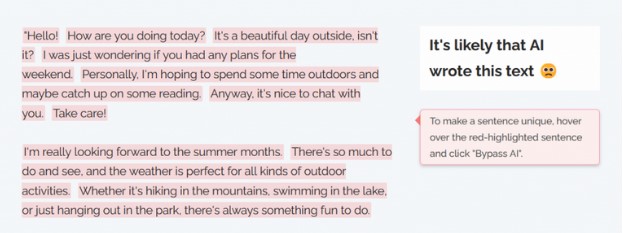
This AI text detector offers an extra feature to users: It helps rephrase sentences that it believes don’t sound human-written. You will see highlighted sentences that need rewriting to bypass AI detection. You can do it yourself or create an account and let the tool do it.
Pros
- Free to use
- Highlights the likely AI-generated sentences
- High accuracy
Cons
- No detailed analysis
- No plagiarism features
| Extra read: How to Avoid Plagiarism: Ways and Tips |
Summing Up
AI detector tools could be more accurate, but they still help you find and polish weak text patterns for better quality.
Look:
We don’t want to demonize ChatGPT and its alternatives. They are excellent productivity tools, assisting with research and low-effort repetitive tasks. (Use them to write content briefs, essay outlines, social media posts, or product descriptions.) Some are like our essay title generator, helping you find ideas for future papers.
However:
We don’t recommend copying and pasting the generated paragraphs into your essays or web articles. The goal of any content you submit is not only to make it look human-created but to give it your unique viewpoint.
Go to some of the mentioned resources with a “check my essay for AI” request. Evaluate the results and use a few AI detectors that fit your needs. It is hard to say if AI tools will someday reach the level of human writing, but today, they are already enough to improve the quality of content you communicate to the audience.
FAQs on AI Text Detector Tools
What are the limitations of AI writing detector tools?
Most of them don’t showcase the sources of information in the text; therefore, you can’t verify the accuracy of facts and figures. It may lead to plagiarized excerpts in your content and get you into trouble. Plus, these tools aren’t 100% accurate: They often miss AI-generated text blocks or, vice versa, see human-written content as AI-generated. The best option would be to use some fee-based AI detector for essays, as free tools are still too far from perfect.
Can Turnitin spot AI-generated paragraphs?
Turnitin has a feature like Turnitin Originality. Its algorithms detect AI-generated content. Like any other AI-detecting service, it’s not 100% accurate. So, a workaround would be to address a reliable service with your “help me write my essay” request: You’ll save time and get original content with no plagiarism issues, collaborating with talented writing experts.
What factors does the accuracy of an AI essay checker depend on?
The accuracy of an essay scanner for AI depends on four factors:
- Algorithm design. Thus, recurrent and convolutional neural networks are more accurate.
- Evaluation method. The tools tested on real-world data, not test data only, are more accurate.
- Training data. The quality, size, and variety of data developers used to teach AI define the tool’s accuracy.
- Updates. Keeping an AI tool up-to-date makes it more accurate.
What is the algorithm of AI detection?
Like most AI text-generating tools, an AI text detector is an LLM (large language model). Trained on massive content databases, it uses two indicators to evaluate a text:
- Perplexity (how unpredictable a text is)
- Burstiness (how varied its sentence length and structure are)
The lower these two indicators, the more likely the text is AI-generated.
In plain English, an AI content detector looks at your text and thinks, “Hmm, is it anything I could write?” If its answer is “yes,” it marks this text as AI-generated. That’s because human writing tends to have more diverse sentence structure (higher burstiness) and more creative language choices (higher perplexity). In contrast, AI writing is monotonous and predictive, with poor word choice and primitive text structure.
Main photo by Steve Johnson from Unsplash

